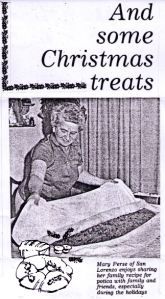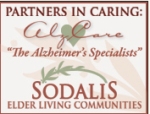
Will an Alzheimer's victim remember this treat from the past.
My mother-in-law Rose (and every Slovenian woman in the neighborhood worth her salt) made wonderful holiday bread called potica. Not “pot’ e ca” – the way it might be pronounced if one put the accent mark on the wrong syllable. Its proper pronunciation is po’ teet sa (po as in potential).
Holiday bread — that’s exactly what it was/is: Easter, Thanksgiving, Christmas, New Years, weddings and any other occasion where there was a celebration – particularly a religious celebration. Many of the women, including Rose, baked the potica in a turkey roasting pan the day before the event. Best described you might look at it and think – “giant cinnamon roll”– only different: more of a bread filled with ground walnuts and honey than a sweet. Lacking an oval-shaped roasting pan, the boa-like roll can be cut into loaf-pan pieces and baked individually.
When I met Ken he mentioned – no, mentioned is not a strong enough word – he bragged that he was 100 percent Yugoslavian. His father, Nick, and Rose’s parents came to America from that part of the world. His dad was just a boy of 15 traveling alone when he entered the U.S. through Ellis Island in 1906. Both Ken and his sister Loretta were extraordinarily proud of their dad’s courageous journey to America and their so-called unique “pure” heritage. I scoffed, telling him that with the world’s dark account of battles and conquest which constantly swept back and forth across the continent like the ebb and flow of endless tsunamis, no one could possibly be 100 percent anything; especially with all the plundering, ravaging and “whatever” which always accompanies the brutality of war. Yet, he persisted.
As our children grew my gene contribution of mixed Anglo-Saxon and Swedish ancestry became so insignificantly incidental I often wondered if my offspring could have been birthed by a surrogate Slovenian woman and I hung around to do the cooking, cleaning and child rearing. Consequently, and to hang on to my own identity I declared war on making potica, becoming the unnoticed resistance having no desire to make the celebrated bread. I did have, though, a fabulous recipe for a Swedish tea ring which I made more often than Rose or Ken’s Aunt Mary, who lived close by, made potica.
Our girls, as adults, coaxed the recipe from their grandmother and when they married both of them dutifully made potica, portions of the bread they brought to their grateful father – and me. “Ah,” he would say, “potica — just like my mother bakes. Her parents were from Yugoslavia, you know.”
Following WWI and the fall of the Austria-Hungary empire more than 20 ethnic groups were thrown together to form Yugoslavia which loosely existed under Communism for many years. Powerful Marshal Tito managed to extrapolate the country from Soviet-Stalin dominance in 1945, and continued to rule with his own iron Communist fist for another 35 years. When Tito died in 1980, the Yugoslav government, of which he was the pivotal figure, began to crumble under conflicts and political upheavals. Countries and regions involved wanted to be who they were before WWI. Sadly, new and fierce conflicts ensued. Yugoslavia, as we had known it, faded from the map.
Meanwhile, we discovered that Nick was born in a little town in Austria, which had been obliterated by the Germans during WWII, and Rose’s parents emigrated from Croatia. For a good portion of the century, they had obediently accepted the order of Yugoslavia even though, in their hearts, they knew better. I teased Ken for a long while, as did my brother-in-law Douglas, about him now being a man without a country which he took, unruffled, in his stride. After all, my husband is an American: first generation, but still an American.
As for potica, I did surrender after many years and made the delicious bread. I suppose Rose, herself, might have driven me forward to give it a try when she stayed with us for a few nights after Nick died. I had baked a Swedish tea ring, and in the morning I brewed her coffee and served a slice of my delicacy. “Mmmmm,” she murmured, “Who made the potica.”
I suppose it doesn’t really matter whether it’s potica or tea ring. They are both delicious in their own right. Nor does it matter whose ethnic background is 100 percent anything. We are really one: part of God’s family. Hopefully, someday we’ll all get along so we can enjoy potica and Swedish tea ring at the same banquet in addition to ham, lamb, chicken, sheep heads, beef, squid, octopus eyes, bugs, headcheese, tripe, brains, worms, larva, sea creatures and whatever else is out there for mankind to consider a gourmet delight.
On Thanksgiving Day, our daughter Julie had dinner with Tim’s parents, but on the way they dropped by with buttery sweet potatoes, sausage stuffing and potica. “I wonder if Dad will remember it,” she questioned, and as curious as I was I decided to wait until the next day when the time was quiet and he could concentrate on what he was eating rather than be distracted with so many other foods and a house filled with company.
All by itself on a plate with a little butter he picked up a piece of his heritage food and took a few bites. “Mmmmm,” he said, and then he stuffed the rest of it into his mouth without another word or sign of recognition. Perhaps, though, somewhere in the lost caverns of his diseased mind there may have been a tangled nerve cell groping to identify that little “something” which was so familiar.
FOR YOUR NEW YEAR’S BAKING PLEASURE
Potica
Soak raisins (dark or light) till puffy – about an hour: 11 or 15 oz. box depending on your raisin preference
Potica dough
2 envelopes dry yeast dissolved in ½ cup warm water. Set aside.
2 cups scalded milk. Allow to cool to tepid.
2 tsp salt
¼ cup butter or margarine
½ cup sugar.
2 well-beaten eggs
7 – 8 cups flour
Add readied yeast to lukewarm milk. Add next four ingredients. Beat thoroughly. Beat in some flour and mix till you have to change to a spoon. Mix in remaining flour as if it were bread dough but a little softer. Place in greased bowl.
Cover with dish towel and allow rising till doubled in size.
Potica filling
1-1/2 pounds ground walnuts (7.5 cups shelled nuts – yes, lots).
1 cup honey
½ cup milk
2 eggs
½ cup sugar
1 Tb. Cinnamon
Sprinkle of salt
Stir together. Makes a thick paste.
Cover a very large table (dining room table is good) with a clean flat sheet folded in quarters. Flour lightly. Punch down dough and then roll out in rectangle of about ½” in thickness. It’s big. Smooth paste over surface, sprinkle on raisins. Roll entire piece of dough with filling into a giant jelly roll. Best way is to turn the first edge then let the sheet do the rolling (see photo). Cut into loaf-size pieces and place in greased loaf pans (or greased turkey roaster). Cover with towel and allow doubling in bulk and then bake in 350 degree oven. Remove, rest in pans 5 minutes. Turn out to cool.
Swedish Tea Ring
Soak about 1 cup raisins according to preference, till puffy. (Raisins optional)
Tea Ring dough
2 envelopes dry yeast dissolved in ¼ cup lukewarm water. Set aside.
Blend ½ cup sugar into ¼ cup shortening
1 tsp. salt
2 eggs beaten
1 tsp. grated lemon rind
1 cup milk, scalded and cooled to lukewarm
About 5 cups flour
Stir first five ingredients into cooled milk. Beat. Add enough flour to make batter. Beat well adding as much flour as possible and still be able to beat dough. Stir in remaining flour to make a soft dough. Turn out on lightly floured board and knead until satiny. Place in greased bowl, cover and allow it to rise until doubled in bulk.
Tea Ring filling
Melted butter
Brown sugar
Cinnamon
Chopped nuts
Raisins or other dried fruit (optional)
Powdered sugar icing with just enough lemon juice to drizzle. Chopped nuts
When dough is light, remove from bowl and punch down. Place on lightly floured surface. Knead just a bit. Divide into two sections. Set aside 1 section for 2nd tea ring. Roll 1st section into rectangle about 3/8 inch in thickness. Brush surface with melted butter and sprinkle generously with brown sugar, cinnamon, raisins (optional) and nuts; amounts in preference. Roll like jelly roll bringing ends together to form circle. Tuck ends inside one to the other. Place circle on greased baking sheet, or round pizza pan. With scissors, cut circle at 1-inch intervals to near center. Twist each section under and up. Allow to rise once again until doubled in bulk. Bake in moderate oven (375 degrees) 25 to 30 minutes. While still warm, drizzle with icing made with powdered sugar diluted with lemon juice and milk. Careful when adding liquid to powdered sugar; you want to drizzle onto the tea ring, but not have it run off. Sprinkle with more chopped nuts. Assemble and bake 2nd tea ring.
















